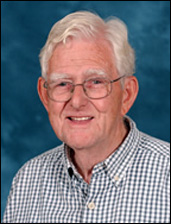Victor Hawthorne
Year: October 16th, 2003
Location: Ann Arbor, MI
Interviewed by: Blackburn, Henry
Abstract
Victor Hawthorne was an early pioneer in CVD epidemiology and a later pioneer in the epidemiology of advanced renal disease. He contributed uniquely to CVD epidemiology in his use of wartime x-ray tuberculosis survey populations of Scotland as a cohort for the Renfrew-Paisley cohort study of CVD, in which he also pioneered use of the Minnesota code classification of its ECGs.
He went on to a distinguished career at the University of Michigan and as Chair of the Epidemiology Study Section of NIH in the 1970s.
Quotes
VH: You may remember in wartime the Committee for the Civilian Population in War Time picked up the mass radiography screening on 35 mm film from the British Navy who had picked it up from the American Navy. TB has always been a major problem in the Navy, particularly in the foc’sls.
Manoel d’Abreu in Rio de Janeiro, adapted the 35 mm camera from Hollywood; put a florescent screen in front of it… and introduced this mass screening thing. Very cheap, very quick and the Navy picked it up… and the civilian population in war time established mass screening for the entire population.
This is screening so you worked quickly and hopefully did not miss anything. All sorts of odd things you’d see in that – bits of shrapnel from WW I and things like that.
HB: But it was your introduction to public health in mass screenings.
VH: Oh, very much, because from that there’s a very short step to thinking of the health of whole populations. The devil finds mischief for idle hands to do and there we are in a black room thinking, “Is this going to be my life? Am I ever going to see the daylight again?” And so I got involved at that point in thinking rather more widely. . .Speaking from memory, I think something like 800,000 were examined in six weeks. Something in that order. It was a big thing. Mass radiography was the start and the mechanism and the law and the great thing, of course, was the confidentiality that was implicit in any communication at all in that.
When that was over in 1959 . . the first thing I did was design a questionnaire on bronchitis, which was torn apart and thoroughly destroyed by Geoffrey Rose and others, you know.
HB: Charles Fletcher had his cough and spittle questionaire by then, didn’t he?
VH: [When I showed up, Fletcher and Donald Reid gambled on who would have me to train] Reid won the toss or lost it, I think. So I started to contact him and Rose and I think I was in London every month learning the niceties of screening. Geoffrey Rose saw the opportunity and so did Donald of pilot mass cardio-respiratory screening and grafting it onto what I was doing in tuberculosis. [I asked my bosses] “Let me go down to London and get Ron Prineas to read the ECGs.” The board of management refused permission. . . So what I did, I closed down the whole mass radiography unit for a week and trained every one of the people in the Minnesota Code. Ron came up and tested us in it. And the best Minnesota coder was a wee girl called Iris. We did our Minnesota coding, and we did our diagnoses more accurately than they did at the Royal and it gave me [the go-ahead]…
HB: Now, whose idea was it to train clerical people [on ECG cding]? Was that your idea, or Donald’s?
VH: Yes. It was my idea. It’s no great idea.
HB: It’s a very great idea because nobody had ever done it before. I mean, Geoffrey began to do it, but I don’t know when he began to do it.
VH: He did it after we demonstrated, I think, that it was feasible…
HB: Interesting.
VH: [For the Renfrew-Paisly project] I bought a lot of those [Rose blood pressure devices] and everyone hated carrying the things around. So that study was done with the Rose box and the angina questionnaire and the [Minnesota-coded] ECGs. And Rose came up with his stopwatch and signals and we prepared for it. Timing how long it took for a patient to be booked in, have blood pressure taken, get to the next station, ECG, drop of blood, respiratory function test. We did the whole gamut.
HB: Was this an MRC study?
VH: No. It was misappropriated government resources.
HB: So I shouldn’t ask anymore.
VH: I grafted it all onto the radiography.
HB: Got it.
VH: Sure. We did all that and then did the chest x-ray.
Full Transcript Access
Full transcripts of interviews may be made available to those engaged with original materials for scholarly studies by contacting us.
